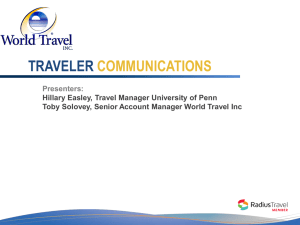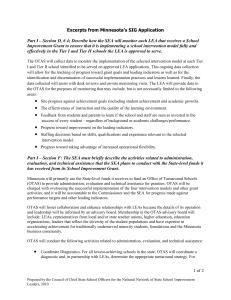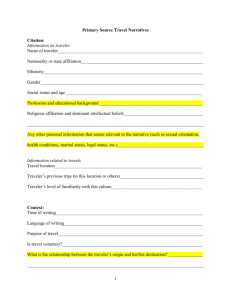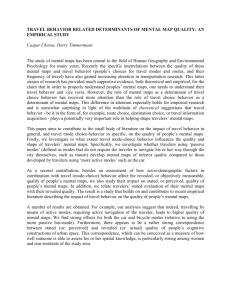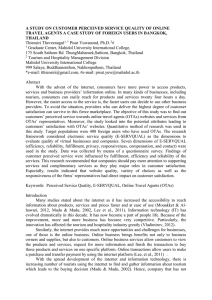Experiential Travel
advertisement
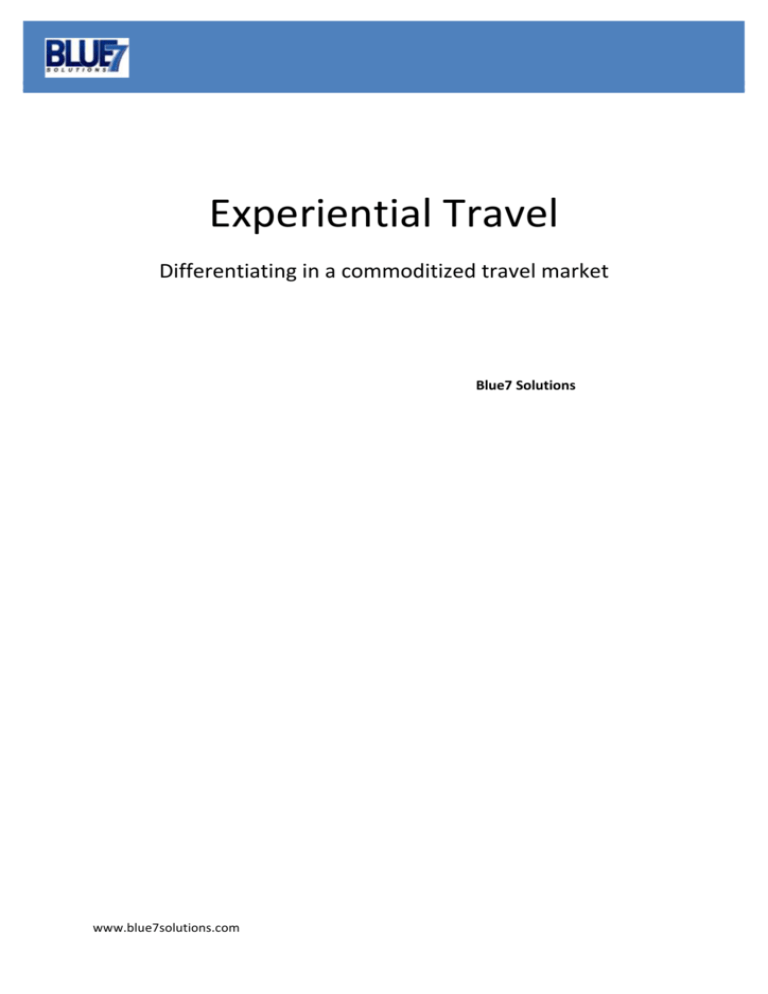
Experiential Travel Differentiating in a commoditized travel market Blue7 Solutions www.blue7solutions.com Abstract In the Online Travel Agents (OTAs) market place, products are comparable, and differentiation is not limited to inventory alone. The travel website, which forms the primary sales channel for OTAs, is constantly challenged to differentiate themselves from other similar sites. Research in OTA consumer behavior indicates that price, functionality, and site design are the biggest challenges for a prospective customer. The ‘City-­‐pair’ approach typically followed by OTAs fails to create utility in the minds of the consumers. OTAs eventually compete on price and though sales may grow, profit margins come under pressure. OTAs respond by working harder to sell their products, increasing sales costs, and reducing profit margins. Differentiation compels OTAs to sell their services at more competitive prices. This is the “commoditization trap” OTAs can break free from the commoditization trap by offering unique capabilities (products, services, and user experience) that helps deliver value to the consumers. This also helps in elevating the utility of the OTA website in the mind of the traveller. Thus, to sustain in today’s competitive environment, OTAs need to innovate and provide the best travel experiences to their consumers. www.blue7solutions.com The paper discusses the limitations of common booking processes and describes how OTAs can gain competitive advantage by providing an innovative travel booking experience to its customers. The objectives of the paper are to: • • Define the need and opportunity to innovate Explain how OTAs can create simple differentiations with technology as the key agent Need and Opportunity to Innovate As per the research conducted by PhoCusWright, 49% of the surveyed travelers in developed markets (US, UK, Germany) and 66% in emerging markets (India, Brazil, Russia) do not have a defined destination while initiating the trip planning process. As a result, it may not be ideal to insist the traveler to specify a destination during the planning process. Let’s understand the need to innovate. Discretionary vs Non-­‐Discretionary Traveler Leisure travelers can be classified into 2 categories based on the travel motive. • Discretionary • Non-­‐Discretionary Non-­‐Discretionary Travel is defined by an external need, such as an event to be attended, a social obligation, or visiting friends/family. In this case, trip details, such as destination, travel dates, and duration of stay are predetermined. The traveler has multiple useful sites available to identify the best travel option, such as hotels, flight options, and ground transportation. The traveler can read reviews, and compare options and cost. Cost is usually the key consideration. There are a large number of discretionary travelers, for whom the purpose of travel is largely self-­‐aspirational. Discretionary travelers usually travel for adventure, relaxation, and togetherness. A discretionary traveler is a prosumer – who is an experienced holiday planner and understands how to plan the travel online using new tools and technology. Often the traveler searches for a destination driven by emotional and experiential needs. Destination selection is the most complex decision for a discretionary traveler. Though cost is important, it is not the only consideration. A discretionary traveler, who is personally involved in selecting a destination, is observed to spend more than those who are not involved in the process of selecting a destination. We can conclude that the needs of discretionary and non-­‐discretionary travelers are different, and travel websites need to engage them differently. Most of the OTA websites require travelers to specify a destination. As a result, they fail to effectively engage the discretionary traveler. In today’s competitive marketplace, this leads to a loss of large revenue opportunity. Allowing the traveler to search for a destination can help engage the discretionary traveler and increase customer base. Also, engaging the traveler early in the trip planning process can increase the utility of a website and increase the selling propensity. www.blue7solutions.com Commoditization Trap Booking functionality and features provided on the OTA websites are usually similar. In an OTA market place, where the products are comparable, differentiation cannot be built on inventory alone. This has resulted in commoditization of booking related functionality. Commoditization results in a significant problem – since there is little to differentiate products/services from that of competitor’s, OTAs compete on price. Though competitive pricing may grow sales, OTA ends up compromising the profit margins. Competitive pressures compel OTA to continue to offer competitive rates on sustained basis until it becomes unviable to sustain. This is the “commoditization trap”. OTAs can offer innovative user experience to elevate the utility of the OTA’s website and help deliver value to the traveler. OTAs can deliver differentiating and persuasive user experience by using a mix of visuals, videos, contextual text, and interactivity. Elevating the utility of the OTA website can help fosters customer loyalty, and enhances brand appeal and help OTA to avoid competing only on price and thus avoid the commoditization trap. OTAs can offer unique, differentiating experience to drive revenue and margin growth by: • Providing the ability to identify and compare destination(s) • Engaging visuals and videos • Providing contextual destination information Information Overload Trip planning often requires consumer to sift through great amount information and one of the prime sources of frustration is too much information or too little relevant information. Discretionary travelers are flexible on travel aspects, such as dates and transit times. This mandates OTAs to provide more and relevant options to consumer within a certain criteria. This is the cause for having to browse through too much of information before being able to select the destination. Based on research, approximately 42% of consumers experience frustration while selecting a destination online. Growth of Mobility & Social Networking Mobility is predominantly being used by travelers for booking and in-­‐travel activities, such as booking travel product, managing itinerary, receiving alerts, sharing trips, and accessing location based information. Use of social networks to receive advice is also gaining popularity. For travelers who are new to planning online travel, social networks are becoming an important source of information to help booking. However, social networks offer minimal aid for planning trips and identifying the destination. Mobility and social networking have become pervasive. OTAs can innovatively use mobility and social networks to create a more engaging trip planning process. For example, OTAs can use mobility and social networks to plan trips collaboratively with family/ friends, get recommendations on destinations and local activities, and share travel itineraries. www.blue7solutions.com How to Create the Differentiation? OTAs can use a combination of functional features, presentation, personalization, and cumulative intelligence to provide distinct capabilities and compelling user experiences. The basic objective of an experiential travel framework should be to help the traveler fulfill their experiential (emotional) aspirations – not merely sell travel products. To create differentiation in the highly commoditized market place, OTAs should: • • • • Engage to Inspire o Support trip planning and shopping in addition to booking. o Provide the ability to search for destinations by Theme and Activity, Budget, Travel Dates, and Travel Time/ Distance Traveler Ratings. OTAs should aim to provide more relevant options that meet the consumer’s experiential needs and budgetary constraints, without overwhelming the consumer. o Provide more control to the user, and reduce information overload. OTAs can use decision trees to present summary information, and then allow consumers to drill down for more details. o Encourage personalization – Leverage traveler profile, preferences, and collective behavioral intelligence to deliver targeted content and reduce information overload. o Minimize points of frustration through incremental measures, increased utility of the website, and help build loyalty with the online booker. Inspire to Convert -­‐ Active Persuasion o Use a mash-­‐up of persuasive content, behavioral patterns and social travel trends to improve the user experience and make it compulsive o Include pertinent contextual information, such as relative pricing, climate, and travel trends, which can help the traveler in their decision making process o Integrate social networks – Enable travelers to reach out to peers, friends and family for advice on planning trips, exchanging experiences, and inquiring about accommodation, local attractions, and activities Engage End-­‐To-­‐End and Beyond o Communicate with customers throughout the travel experience lifecycle -­‐ Planning, Shopping, Booking, In-­‐Travel and Post Travel o Increase brand loyalty – Offer/integrate loyalty programs o Increase fidelity through innovative user interface design, personalization, and usability Collective Intelligence o Use the data captured as part of the online user activity to enhance customer intelligence – profile customers, assign them to a particular customer segment, and optimally price and target products/service offerings based on their propensity to accept the offers. o www.blue7solutions.com o Observe the consumer’s interaction on the website. The consumer’s behavior and profile information is used to assign them to customer segments. This intelligence can used to dynamically adjust search results/recommendations by correlating the consumer’s behavior with other fellow travelers. Relative pricing and travel trends (where are other fellow travelers with similar preferences are travelling) displayed in context to the destination information can improve user experience and make the experience compulsive. Conclusion Implementing the above measures can help OTAs drive a competitive advantage by: • • • • • Broadening customer base – engaging large section of prosumer travelers who do not have a destination in mind Improving and measuring effectiveness of marketing offers Increasing website/customer loyalty and improving look-­‐to-­‐book ratios Increasing revenue per passenger – discretionary travelers tend to spend more Increasing conversions and build customer fidelity – Engage a prospective customer early in the buying process Blue7 Solutions, can help OTAs leverage technology to deliver innovative solutions and engage their target customers better. About Blue7 Solutions To sustain themselves in a highly complex and competitive environment, travel companies have to be smarter and nimbler, and need to be highly focused on ensuring maximum mileage for each dollar spent, customer acquisition and retention, customer experience and loyalty, timely price optimization, and product marketing across multiple channels. While creating differentiation and fueling growth, companies need to ensure that they are not compromising on customer loyalty or value addition. Blue7 is uniquely positioned to enable travel companies in traversing the current landscape and become more agile, adaptable, innovative, and effective. Its expertise spans across the travel supply chain —from airlines, hotels, ground transportation, cruise providers, and online or retail booking to intermediaries, distributors, tour operators, travel agencies, vacation rentals, and membership clubs. Blue7 Solutions LLC, a Joint Venture between Blue Star Infotech America Inc. and Trisept Technologies, leverages the extensive technology and solutions experience of both companies to solve business problems of modern day enterprises and software product companies. Based in Milwaukee, WI, USA, Blue7 Solutions provides a range of IT Solutions and Services to customers across several industry verticals such as Travel & Hospitality, Technology, and Manufacturing. Blue7 Solutions brings in the subject matter expertise that fuses Business and IT to deliver positive business outcomes. www.blue7solutions.com References: 1. 2. Empowering Inspiration: The Future of Travel Search http://www.bsil.com/Resource-­‐Center/Press-­‐Releases/2012/04-­‐12-­‐2012.aspx www.blue7solutions.com

